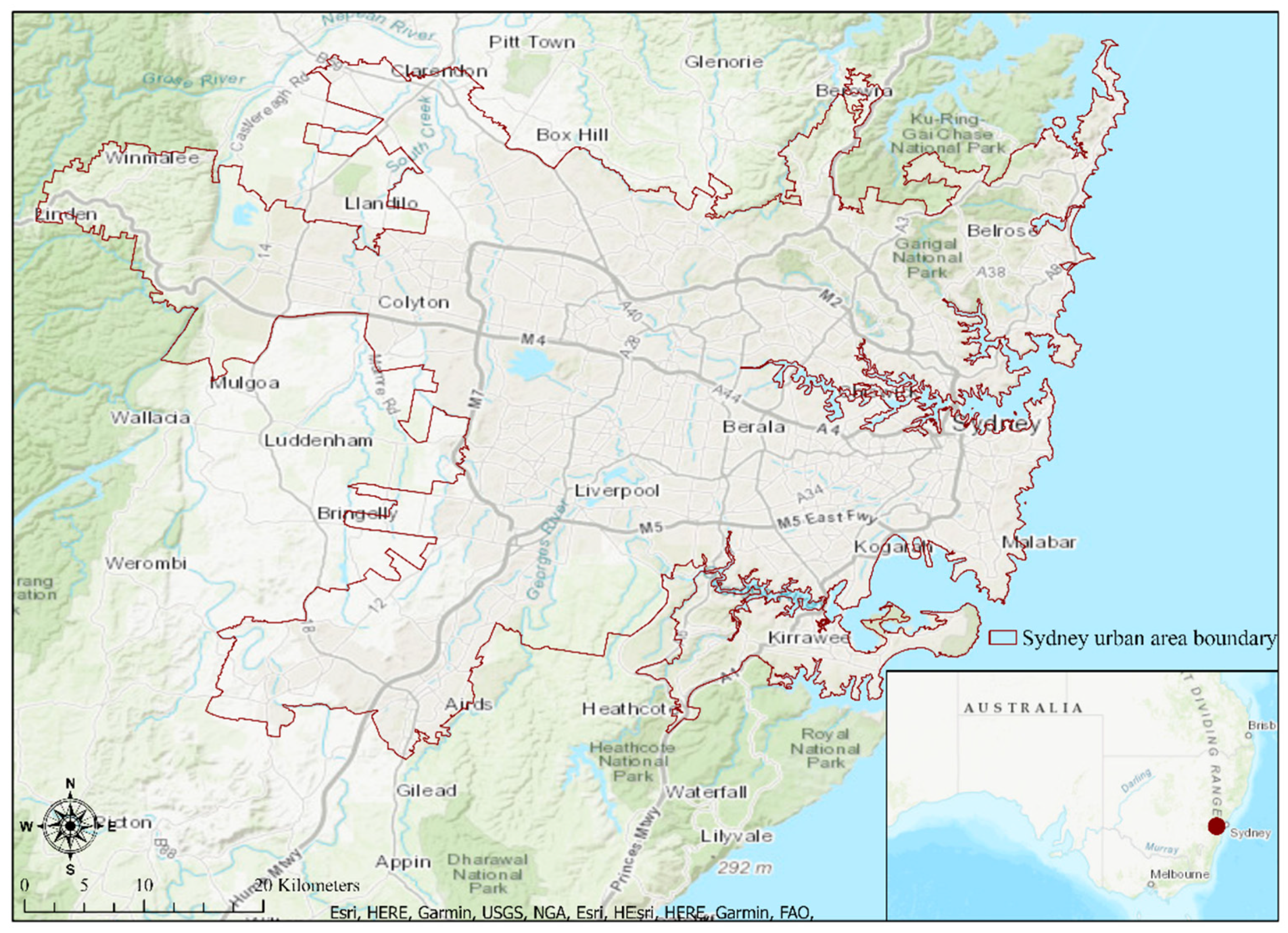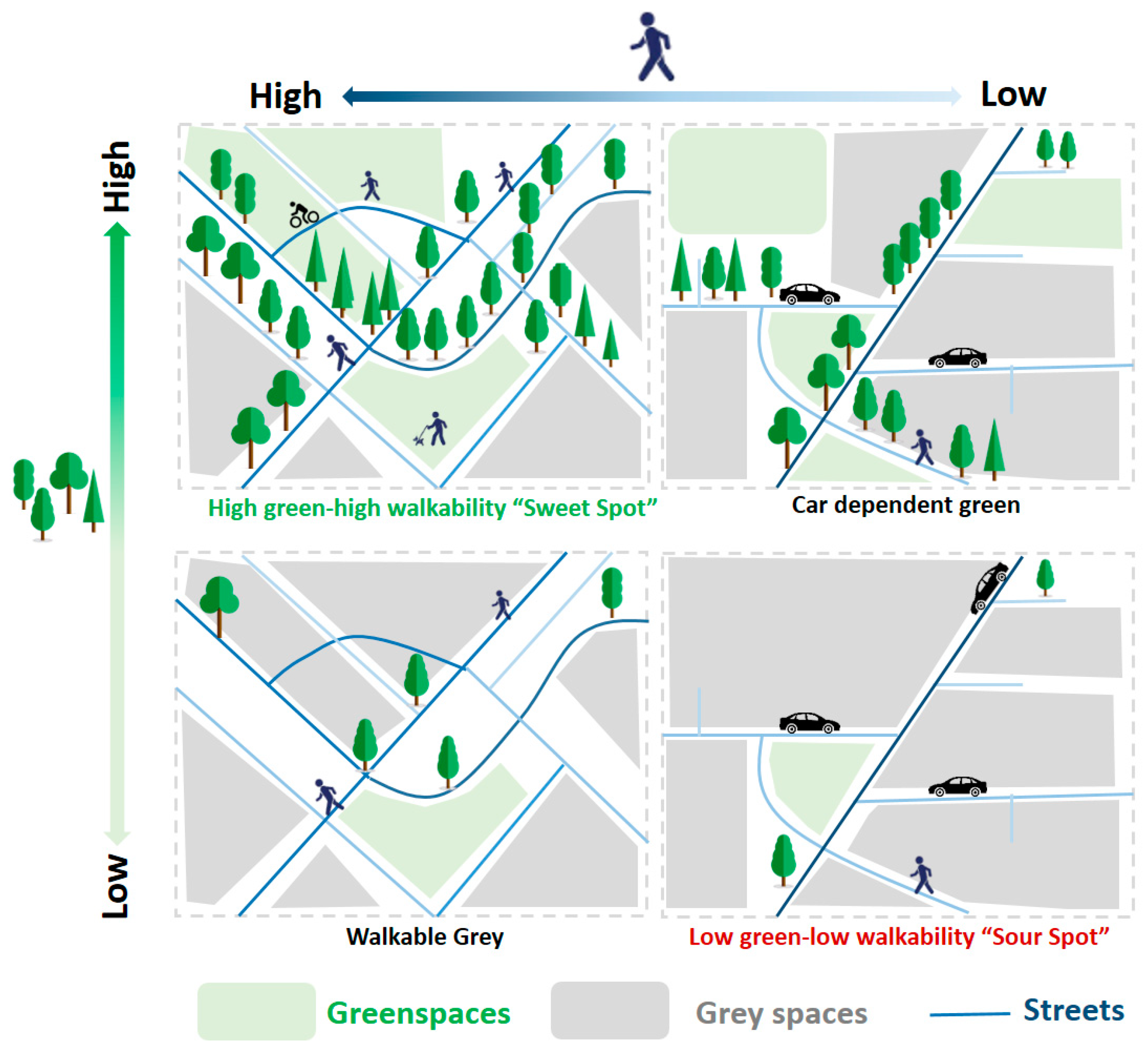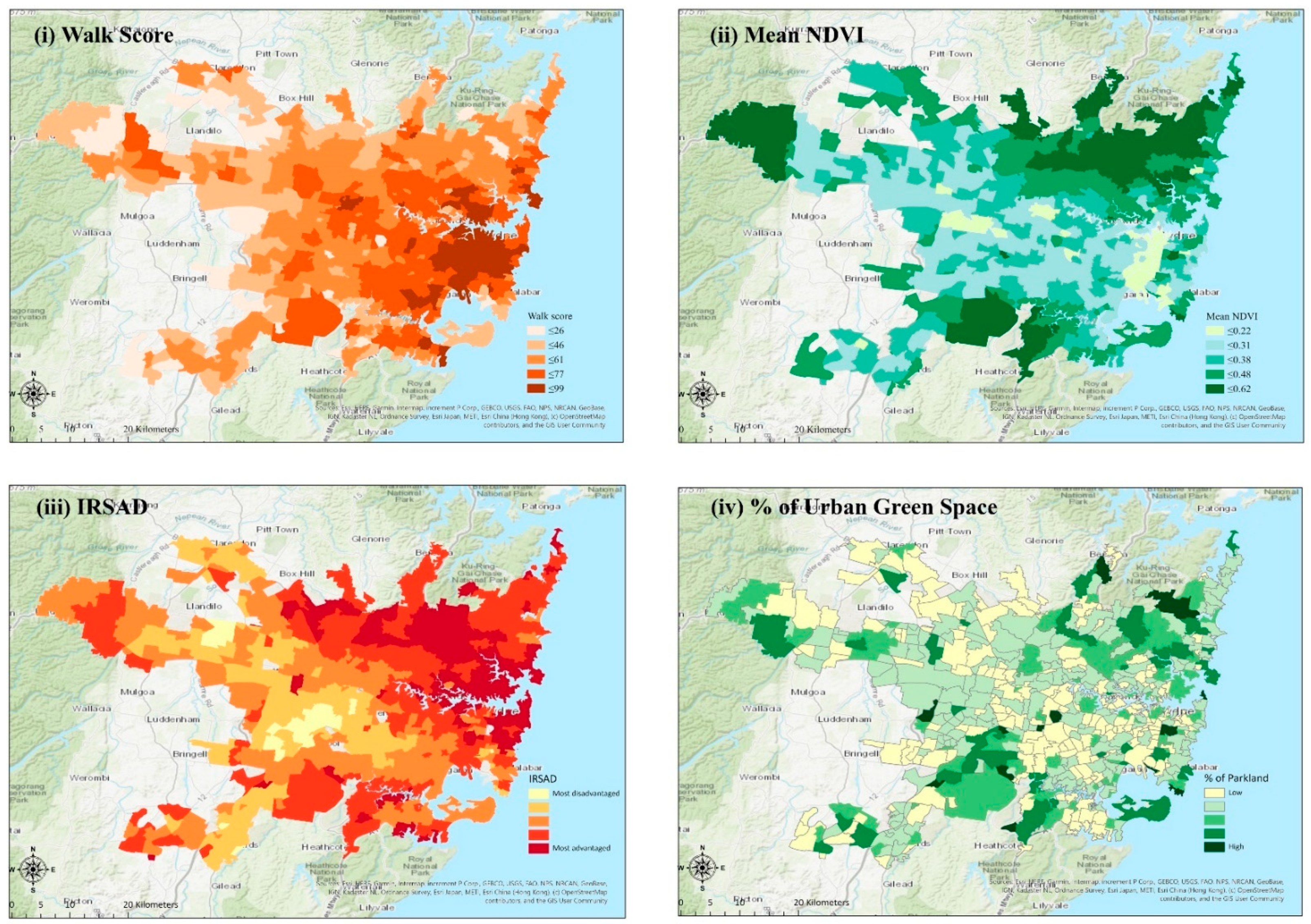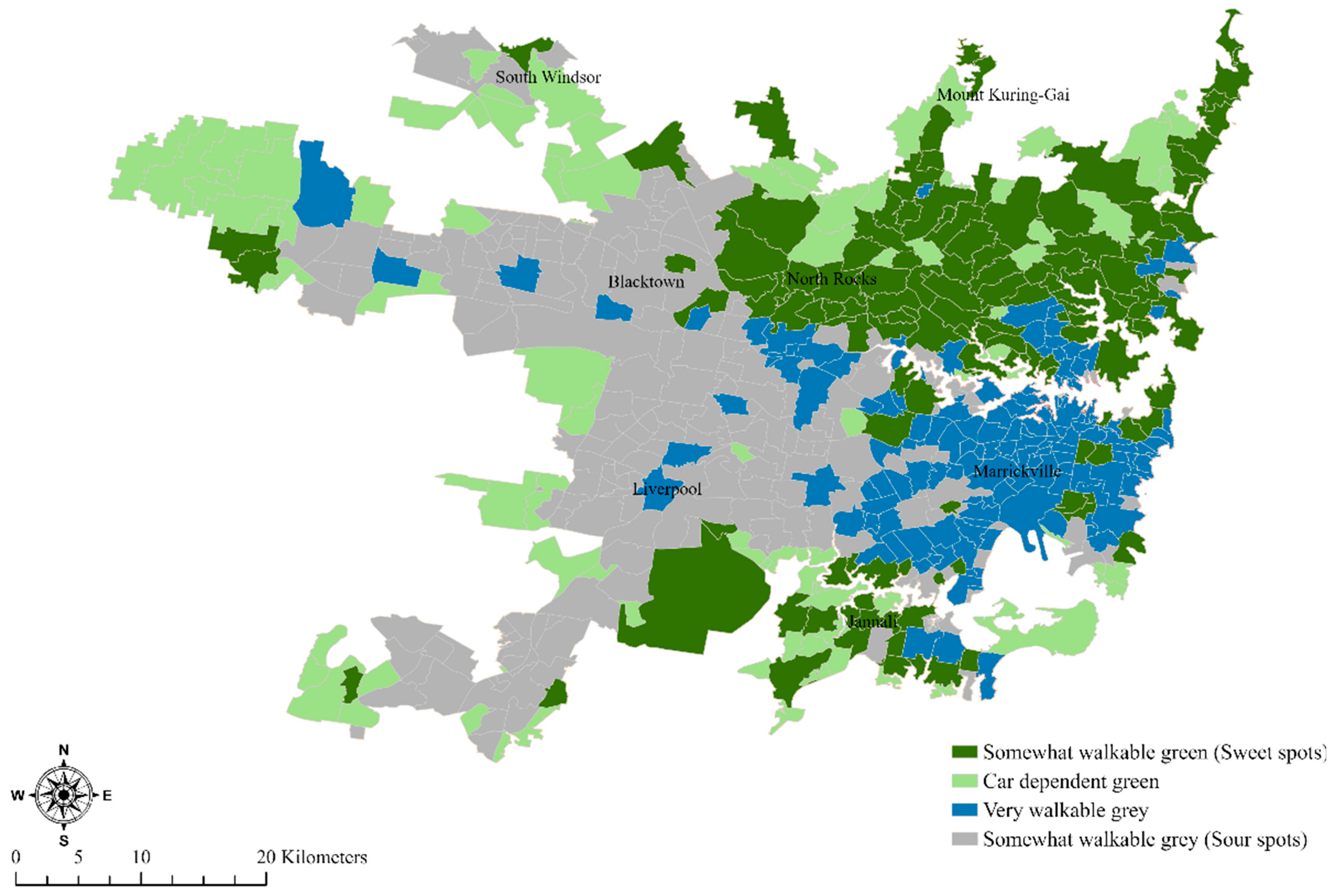Walkability and Greenness Do Not Walk Together: Investigating Associations between Greenness and Walkability in a Large Metropolitan City Context
Abstract
1. Introduction
2. Materials and Methods
2.1. Geography of the Study Area
2.2. Walkability
2.3. Greenness and Green Space Measures
2.4. Other Variables
2.5. Statistical Analyses
2.5.1. Ordinary Least Squares (OLS)
2.5.2. Spatial Statistics
Spatial Lag and Error Model
- (a)
- Spatial Lag Model
- (b)
- Spatial Error Model
Multivariate Clustering
2.6. Implementation of the Models
3. Results
4. Discussion
5. Conclusions
Author Contributions
Funding
Institutional Review Board Statement
Informed Consent Statement
Data Availability Statement
Conflicts of Interest
References
- Houlden, V.; Porto de Albuquerque, J.; Weich, S.; Jarvis, S. A spatial analysis of proximate greenspace and mental wellbeing in London. Appl. Geogr. 2019, 109, 102036. [Google Scholar] [CrossRef]
- Lovasi, G.S.; Grady, S.; Rundle, A. Steps Forward: Review and Recommendations for Research on Walkability, Physical Activity and Cardiovascular Health. Public Health Rev. 2011, 33, 484–506. [Google Scholar] [CrossRef] [PubMed]
- Hartig, T.; Mitchell, R.; de Vries, S.; Frumkin, H. Nature and Health. Annu. Rev. Public Health 2014, 35, 207–228. [Google Scholar] [CrossRef] [PubMed]
- Kabisch, N.; Qureshi, S.; Haase, D. Human–environment interactions in urban green spaces — A systematic review of contemporary issues and prospects for future research. Environ. Impact. Assess. Rev. 2015, 50, 25–34. [Google Scholar] [CrossRef]
- Van den Berg, M.; Wendel-Vos, W.; van Poppel, M.; Kemper, H.; van Mechelen, W.; Maas, J. Health benefits of green spaces in the living environment: A systematic review of epidemiological studies. Urban For. Urban Green. 2015, 14, 806–816. [Google Scholar] [CrossRef]
- Labib, S.M.; Lindley, S.; Huck, J.J. Spatial dimensions of the influence of urban green-blue spaces on human health: A systematic review. Environ. Res. 2020, 180, 108869. [Google Scholar] [CrossRef]
- Bratman, G.N.; Anderson, C.B.; Berman, M.G.; Cochran, B.; de Vries, S.; Flanders, J.; Folke, C.; Frumkin, H.; Gross, J.J.; Hartig, T.; et al. Nature and mental health: An ecosystem service perspective. Sci. Adv. 2019, 5, eaax0903. [Google Scholar] [CrossRef] [PubMed]
- Markevych, I.; Schoierer, J.; Hartig, T.; Chudnovsky, A.; Hystad, P.; Dzhambov, A.M.; de Vries, S.; Triguero-Mas, M.; Brauer, M.; Nieuwenhuijsen, M.J.; et al. Exploring pathways linking greenspace to health: Theoretical and methodological guidance. Environ. Res. 2017, 158, 301–317. [Google Scholar] [CrossRef]
- Shuvo, F.K.; Feng, X.; Astell-Burt, T. Urban green space quality and older adult recreation: An international comparison. Cities Health 2020, 1–21. [Google Scholar] [CrossRef]
- Hooper, P.; Foster, S.; Edwards, N.; Turrell, G.; Burton, N.; Giles-Corti, B.; Brown, W.J. Positive HABITATS for physical activity: Examining use of parks and its contribution to physical activity levels in mid-to older-aged adults. Health Place 2020, 63, 102308. [Google Scholar] [CrossRef]
- Olafsdottir, G.; Cloke, P.; Schulz, A.; Van Dyck, Z.; Eysteinsson, T.; Thorleifsdottir, B.; Vögele, C. Health benefits of walking in nature: A randomized controlled study under conditions of real-life stress. Environ. Behav. 2020, 52, 248–274. [Google Scholar] [CrossRef]
- Hanson, S.; Jones, A. Is there evidence that walking groups have health benefits? A systematic review and meta-analysis. British J. Sports Med. 2015, 49, 710. [Google Scholar] [CrossRef] [PubMed]
- Hogendorf, M.; Oude Groeniger, J.; Noordzij, J.M.; Beenackers, M.A.; van Lenthe, F.J. Longitudinal effects of urban green space on walking and cycling: A fixed effects analysis. Health Place 2020, 61, 102264. [Google Scholar] [CrossRef] [PubMed]
- Wu, J.; Wang, B.; Ta, N.; Zhou, K.; Chai, Y. Does street greenery always promote active travel? Evidence from Beijing. Urban For. Urban Green. 2020, 56, 126886. [Google Scholar] [CrossRef]
- Veitch, J.; Ball, K.; Crawford, D.; Abbott, G.; Salmon, J. Is park visitation associated with leisure-time and transportation physical activity? Prev. Med. 2013, 57, 732–734. [Google Scholar] [CrossRef] [PubMed]
- Pfeiffer, D.; Ehlenz, M.M.; Andrade, R.; Cloutier, S.; Larson, K.L. Do Neighborhood Walkability, Transit, and Parks Relate to Residents’ Life Satisfaction? J. Am. Plann. Assoc. 2020, 86, 171–187. [Google Scholar] [CrossRef]
- Mazumdar, S.; Learnihan, V.; Cochrane, T.; Phung, H.; Connor, B.; Davey, R. Is Walk Score associated with hospital admissions from chronic diseases? Evidence from a cross-sectional study in a high socioeconomic status Australian city-state. BMJ Open 2016, 6, e012548. [Google Scholar] [CrossRef] [PubMed]
- Clark, C.; Sbihi, H.; Tamburic, L.; Brauer, M.; Frank Lawrence, D.; Davies Hugh, W. Association of Long-Term Exposure to Transportation Noise and Traffic-Related Air Pollution with the Incidence of Diabetes: A Prospective Cohort Study. Environ. Health Perspect. 2017, 125, 087025. [Google Scholar] [CrossRef]
- Doiron, D.; Setton, E.M.; Shairsingh, K.; Brauer, M.; Hystad, P.; Ross, N.A.; Brook, J.R. Healthy built environment: Spatial patterns and relationships of multiple exposures and deprivation in Toronto, Montreal and Vancouver. Environ. Int. 2020, 143, 106003. [Google Scholar] [CrossRef]
- Marquet, O.; Floyd, M.F.; James, P.; Glanz, K.; Jennings, V.; Jankowska, M.M.; Kerr, J.; Hipp, J.A. Associations Between Worksite Walkability, Greenness, and Physical Activity Around Work. Environ. Behav. 2018, 52, 139–163. [Google Scholar] [CrossRef]
- Labib, S.M.; Lindley, S.; Huck, J.J. Scale effects in remotely sensed greenspace metrics and how to mitigate them for environmental health exposure assessment. Comput. Environ. Urban. Syst. 2020, 82, 101501. [Google Scholar] [CrossRef]
- James, P.; Banay, R.F.; Hart, J.E.; Laden, F. A review of the health benefits of greenness. Curr. Epidemiol. Rep. 2015, 2, 131–142. [Google Scholar] [CrossRef] [PubMed]
- Mazumdar, S.; Dunshea, A.; Chong, S.; Jalaludin, B. Tree Canopy Cover Is Best Associated with Perceptions of Greenspace: A Short Communication. Int. J. Environ. Res. Public Health 2020, 17, 6501. [Google Scholar] [CrossRef]
- Browning, M.; Lee, K. Within What Distance Does “Greenness” Best Predict Physical Health? A Systematic Review of Articles with GIS Buffer Analyses across the Lifespan. Int. J. Environ. Res. Public Health 2017, 14, 675. [Google Scholar] [CrossRef]
- Cowie, C.T.; Ding, D.; Rolfe, M.I.; Mayne, D.J.; Jalaludin, B.; Bauman, A.; Morgan, G.G. Neighbourhood walkability, road density and socio-economic status in Sydney, Australia. Environ. Health 2016, 15, 58. [Google Scholar] [CrossRef] [PubMed]
- Schüle, S.A.; Gabriel, K.M.A.; Bolte, G. Relationship between neighbourhood socioeconomic position and neighbourhood public green space availability: An environmental inequality analysis in a large German city applying generalized linear models. Int. J. Hyg. Environ. Health 2017, 220, 711–718. [Google Scholar] [CrossRef]
- Australian Bureau of Statistics. Australian Statistical Geography Standard (ASGS): Volume 4–Significant Urban Areas, Urban Centres and Localities. July 2016. Available online: https://www.abs.gov.au/ausstats/abs@.nsf/Lookup/by%20Subject/1270.0.55.004~July%202016~Main%20Features~Design%20of%20UCL~8 (accessed on 12 December 2020).
- Australian Bureau of Statistics. Australian Statistical Geography Standard (ASGS): Volume 3. Available online: https://www.abs.gov.au/ausstats/abs@.nsf/mf/1270.0.55.003 (accessed on 12 December 2020).
- Leslie, E.; Coffee, N.; Frank, L.; Owen, N.; Bauman, A.; Hugo, G. Walkability of local communities: Using geographic information systems to objectively assess relevant environmental attributes. Health Place 2007, 13, 111–122. [Google Scholar] [CrossRef]
- Nyunt, M.S.Z.; Shuvo, F.K.; Eng, J.Y.; Yap, K.B.; Scherer, S.; Hee, L.M.; Chan, S.P.; Ng, T.P. Objective and subjective measures of neighborhood environment (NE): Relationships with transportation physical activity among older persons. Int. J. Behav. Nutr. Phys. Act. 2015, 12, 108. [Google Scholar] [CrossRef]
- Forsyth, A. What is a walkable place? The walkability debate in urban design. Urban Des. Int. 2015, 20, 274–292. [Google Scholar] [CrossRef]
- Linda, D.; Anna, K.-G.; Bernd, R.; Peter, Z. Defining and assessing walkability: A concept for an integrated approach using surveys, biosensors and geospatial analysis. Urban Dev. Issues 2019, 62, 5–15. [Google Scholar] [CrossRef]
- Hall, C.M.; Ram, Y. Walk score® and its potential contribution to the study of active transport and walkability: A critical and systematic review. Transp. Res. D Trans. Environ. 2018, 61, 310–324. [Google Scholar] [CrossRef]
- Mazumdar, S.; Bagheri, N.; Chong, S.; Cochrane, T.; Jalaludin, B.; Davey, R. A Hotspot of Walking in and around the Central Business District: Leveraging Coarsely Geocoded Routinely Collected Data. Appl. Spat. Anal. Policy 2019, 1–20. [Google Scholar] [CrossRef]
- Duncan, D.T.; Aldstadt, J.; Whalen, J.; Melly, S.J.; Gortmaker, S.L. Validation of Walk Score® for Estimating Neighborhood Walkability: An Analysis of Four US Metropolitan Areas. Int. J. Environ. Res. Public Health 2011, 8, 4160. [Google Scholar] [CrossRef] [PubMed]
- Walk Score. Walk Score Methodology. Available online: https://www.walkscore.com/methodology.shtml (accessed on 10 November 2020).
- Labib, S.M.; Harris, A. The potentials of Sentinel-2 and LandSat-8 data in green infrastructure extraction, using object based image analysis (OBIA) method. Eur. J. Remote Sens. 2018, 51, 231–240. [Google Scholar] [CrossRef]
- Drusch, M.; Del Bello, U.; Carlier, S.; Colin, O.; Fernandez, V.; Gascon, F.; Hoersch, B.; Isola, C.; Laberinti, P.; Martimort, P.; et al. Sentinel-2: ESA’s Optical High-Resolution Mission for GMES Operational Services. Remote Sens. Environ. 2012, 120, 25–36. [Google Scholar] [CrossRef]
- Su, J.G.; Dadvand, P.; Nieuwenhuijsen, M.J.; Bartoll, X.; Jerrett, M. Associations of green space metrics with health and behavior outcomes at different buffer sizes and remote sensing sensor resolutions. Environ. Int. 2019, 126, 162–170. [Google Scholar] [CrossRef]
- Australian Bureau of Statistics. Australian Statistical Geography Standard (ASGS): Volume 1–Main Structure and Greater Capital City Statistical Areas. July 2016. Available online: https://www.abs.gov.au/ausstats/abs@.nsf/Lookup/by%20Subject/1270.0.55.001~July%202016~Main%20Features~Mesh%20Blocks%20(MB)~10012 (accessed on 14 December 2020).
- Mollalo, A.; Vahedi, B.; Rivera, K.M. GIS-based spatial modeling of COVID-19 incidence rate in the continental United States. Sci. Total Environ. 2020, 728, 138884. [Google Scholar] [CrossRef] [PubMed]
- Anselin, L.; Syabri, I.; Kho, Y. GeoDa: An Introduction to Spatial Data Analysis. In Handbook of Applied Spatial Analysis: Software Tools, Methods and Applications; Fischer, M.M., Getis, A., Eds.; Springer: Berlin/Heidelberg, Germany, 2010; pp. 73–89. [Google Scholar]
- Waller, L.A.; Gotway, C.A. Applied Spatial Statistics for Public Health Data; John Wiley & Sons: Hoboken, NJ, USA, 2004; Volume 368. [Google Scholar]
- Anselin, L. GeoDa 0.9 User’s Guide. Available online: https://geodacenter.github.io/docs/geoda093.pdf (accessed on 8 January 2021).
- ArcGIS Pro 2.1 Environmental Systems Research Institute, Redland, CA. 2018. Available online: https://pro.arcgis.com/en/pro-app/2.6/get-started/what-s-new-in-arcgis-pro-2-1.htm (accessed on 12 November 2020).
- Bureau of Meterology. Map Information—Normalised Difference Vegetation Index. Available online: http://www.bom.gov.au/climate/austmaps/about-ndvi-maps.shtml (accessed on 25 December 2020).
- Wallner, R. GIS measures of residential property views. J. Real Estate Lit. 2014, 20, 225–244. [Google Scholar]
- Rhew, I.C.; Vander Stoep, A.; Kearney, A.; Smith, N.L.; Dunbar, M.D. Validation of the Normalized Difference Vegetation Index as a Measure of Neighborhood Greenness. Ann. Epidemiol. 2011, 21, 946–952. [Google Scholar] [CrossRef] [PubMed]
- Li, X.; Zhang, C.; Li, W.; Ricard, R.; Meng, Q.; Zhang, W. Assessing street-level urban greenery using Google Street View and a modified green view index. Urban For. Urban Green. 2015, 14, 675–685. [Google Scholar] [CrossRef]
- Tabrizian, P.; Baran, P.K.; Van Berkel, D.; Mitasova, H.; Meentemeyer, R. Modeling restorative potential of urban environments by coupling viewscape analysis of lidar data with experiments in immersive virtual environments. Landsc. Urban Plan. 2020, 195, 103704. [Google Scholar] [CrossRef]
- Labib, S.M.; Huck, J.J.; Lindley, S. Modelling and mapping eye-level greenness visibility exposure using multi-source data at high spatial resolutions. Sci. Total Environ. 2021, 755, 143050. [Google Scholar] [CrossRef] [PubMed]
- Holt, D.; Steel, D.; Tranmer, M.; Wrigley, N. Aggregation and ecological effects in geographically based data. Geogr. Anal. 1996, 28, 244–261. [Google Scholar] [CrossRef]
- Subramanian, S.; Jones, K.; Kaddour, A.; Krieger, N. Revisiting Robinson: The perils of individualistic and ecologic fallacy. Int. J. Epidemiol. 2009, 38, 342–360. [Google Scholar] [CrossRef] [PubMed]
- Carstairs, V. Deprivation indices: Their interpretation and use in relation to health. J. Epidemiol. Community Health 1995, 49, 3–8. [Google Scholar] [CrossRef]
- Singh, G.K. Area deprivation and widening inequalities in US mortality, 1969–1998. Am. J. Public Health 2003, 93, 1137–1143. [Google Scholar] [CrossRef]
- Younsi, M.; Chakroun, M. Comparing Individual and Area-Based Socioeconomic Measures for Monitoring Social Health Inequalities in Tunisia. J. Knowl. Econ. 2018, 9, 1270–1290. [Google Scholar] [CrossRef]
- Tilt, J.; Unfried, T.; Roca, B. Neighborhood Greenness, Walkable Destinations and Health. In Proceedings of the Active Living Research Annual Conference, Coronado, CA, USA, 16–18 February 2006. [Google Scholar]
- Mazumdar, S.; Fletcher-Lartey, S.M.; Zajaczkowski, P.; Jalaludin, B. Giardiasis notifications are associated with socioeconomic status in Sydney, Australia: A spatial analysis. Aust. N. Z. J. Public Health 2020, 44, 508–513. [Google Scholar] [CrossRef]
- Lee, C.L.; Piracha, A.; Fan, Y. Another Tale of Two Cities: Access to Jobs Divides Sydney along the ‘Latte Line’. Available online: https://theconversation.com/another-tale-of-two-cities-access-to-jobs-divides-sydney-along-the-latte-line-96907 (accessed on 22 January 2021).
- Cahill, D. Sydney’s Most Expensive Suburbs. Available online: https://www.realestate.com.au/news/most-expensive-suburbs-in-sydney/ (accessed on 25 January 2021).
- Astell-Burt, T.; Feng, X. Association of Urban Green Space with Mental Health and General Health Among Adults in Australia. JAMA. Netw. Open 2019, 2, e198209. [Google Scholar] [CrossRef]
- Boyle, A.; Barrilleaux, C.; Scheller, D. Does Walkability Influence Housing Prices? Soc. Sci. Q. 2014, 95, 852–867. [Google Scholar] [CrossRef]
- World Health Organization. Urban Green Spaces: A Brief for Action. Available online: https://www.euro.who.int/en/health-topics/environment-and-health/urban-health/publications/2017/urban-green-spaces-a-brief-for-action-2017 (accessed on 5 January 2021).
- Greater Sydney Commision. Increasing Urban Tree Canopy Cover and Delivering Green Grid Connections. Available online: https://www.greater.sydney/western-city-district-plan/sustainability/city-its-landscape/increasing-urban-tree-canopy-cover-and (accessed on 20 January 2021).
- WSROC. Turn Down the Heat: Strategy and Action Plan. Available online: https://wsroc.com.au/media-a-resources/reports/send/3-reports/286-turn-down-the-heat-strategy-and-action-plan-2018 (accessed on 16 January 2021).




| Variables | Mean | Min | Max | Std Dev |
|---|---|---|---|---|
| Neighborhood size (sq. km) | 3.45 | 0.107 | 60.35 | 4.29 |
| Walk Score® | 57.18 | 0 | 99 | 20.12 |
| Mean NDVI | 0.35 | 0.06 | 0.62 | 0.10 |
| Percent green space | 19.35 | 0 | 100 | 18.30 |
| IRSAD score | 1055 | 623 | 1207 | 98.12 |
| Population density (per sq. km) | 3363 | 5 | 32,681 | 2990 |
| Variable | Coefficient (with 95% CI) | VIF | Adjusted-R2 | AIC |
|---|---|---|---|---|
| Intercept | 28.03 ** | --- | 0.4447 | 4867.1 |
| Mean NDVI | −81.15 ** | 1.72 | ||
| Percent green space | 10.87 * | 1.23 | ||
| IRSAD score | 0.05 ** | 1.18 | ||
| Population density | 0.002 ** | 1.61 | ||
| Suburb size (sq. km) | −0.11 | 1.11 |
| Variable | Co-Efficient | Z-Score | R2 | AICs | ||||
|---|---|---|---|---|---|---|---|---|
| SLM | SEM | SLM | SEM | SLM | SEM | SLM | SEM | |
| Intercept | 14.69 | 61.19 | 3.72 ** | 12.86 ** | 0.6642 | 0.6724 | 4633.01 | 4645.01 |
| Mean NDVI | −44.60 | −71.76 | −6.48 ** | −8.89 ** | ||||
| Percent green space | 1.92 | 9.61 × 10−7 | 0.62 | 5.61 ** | ||||
| IRSAD score | 0.02 | 0.01 | 5.52 ** | 3.56 ** | ||||
| Population density | 0.001 | 0.001 | 6.40 ** | 4.67 ** | ||||
| Suburb size (sq. km) | 0.23 | 0.47 | 1.63 | 3.41 ** | ||||
| ρ | 0.60 | |||||||
| λ | 0.71 | |||||||
| Cluster | Median Walk Score® | Median NDVI |
|---|---|---|
| Somewhat walkable green (sweet spots) | 60 (54, 69) | 0.44 (0.4, 0.5) |
| Car dependent green | 30 (20, 38) | 0.46 (0.41, 0.53) |
| Very walkable gray | 81 (73, 87) | 0.27 (0.22, 0.31) |
| Somewhat walkable gray (sour spots) | 51 (45, 58) | 0.31 (0.29, 0.35) |
Publisher’s Note: MDPI stays neutral with regard to jurisdictional claims in published maps and institutional affiliations. |
© 2021 by the authors. Licensee MDPI, Basel, Switzerland. This article is an open access article distributed under the terms and conditions of the Creative Commons Attribution (CC BY) license (https://creativecommons.org/licenses/by/4.0/).
Share and Cite
Shuvo, F.K.; Mazumdar, S.; Labib, S.M. Walkability and Greenness Do Not Walk Together: Investigating Associations between Greenness and Walkability in a Large Metropolitan City Context. Int. J. Environ. Res. Public Health 2021, 18, 4429. https://doi.org/10.3390/ijerph18094429
Shuvo FK, Mazumdar S, Labib SM. Walkability and Greenness Do Not Walk Together: Investigating Associations between Greenness and Walkability in a Large Metropolitan City Context. International Journal of Environmental Research and Public Health. 2021; 18(9):4429. https://doi.org/10.3390/ijerph18094429
Chicago/Turabian StyleShuvo, Faysal Kabir, Soumya Mazumdar, and S. M. Labib. 2021. "Walkability and Greenness Do Not Walk Together: Investigating Associations between Greenness and Walkability in a Large Metropolitan City Context" International Journal of Environmental Research and Public Health 18, no. 9: 4429. https://doi.org/10.3390/ijerph18094429
APA StyleShuvo, F. K., Mazumdar, S., & Labib, S. M. (2021). Walkability and Greenness Do Not Walk Together: Investigating Associations between Greenness and Walkability in a Large Metropolitan City Context. International Journal of Environmental Research and Public Health, 18(9), 4429. https://doi.org/10.3390/ijerph18094429






